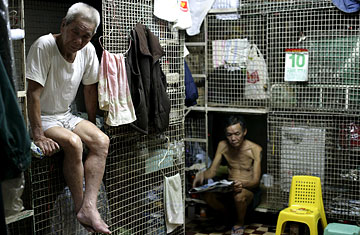
Residents sit in their cage homes in Hong Kong's Tai Kok Tsui district
It's cramped and stale in what Lau Chi-lok calls home: a 20-square-foot portion of an apartment that he shares with 21 other men. For $167 a month, Lau gets the top bunk in what the government euphemistically calls a "bed space," or cubicle dwelling — a tiny rectangular area, partitioned by thin wooden slabs or steel mesh wire to safeguard the resident's belongings, barely large enough for a mattress.
At least there's air-conditioning, turned on at 9 p.m. every summer night. For most people in Hong Kong, the lives of Lau and his roommates are a world apart, hidden behind gated doors and dark stairways. But this is home to thousands of Hong Kong's urban slum dwellers, who are barely making ends meet and — in this year's downturn — putting off dreams of a better life. Across Victoria Harbour from Hong Kong's central business district, in a neighborhood of bright neon signs and bustling vendors, 33-year-old Lai Man-law has been looking for a job for the past year while living in a mesh-wire 18-square-foot cage. "It's dirty and hot. There are cockroaches and bedbugs, and the air-conditioning doesn't work," he says.
Every major metropolis has its share of slums; the U.N. estimates that one-third of the developing world's urban population lives in them, with nearly 40% of East Asian urban dwellers living in slum conditions. In Hong Kong, the worst of those are the cages, a notorious feature of this metropolis. Throughout the city, pockets of grimy, small, privately owned apartments are partitioned into about 10 cubicle dwellings, many with a shared toilet and shower in the corner. Most residents are the working poor, others are mentally ill, elderly, children and the occasional drug addict. Beyond the dwellings' crushingly small size, residents must battle poor hygiene, exposure to electrical wires and heat during the extremely humid summer months. It's difficult to pinpoint an accurate number of people living in conditions like Lau's because many live in private tenements, but social workers estimate at least 100,000 people live in inadequate housing, a category that includes cubicle, cage, rooftop and partitioned dwellings.
It's a side of the city that you don't often hear about — even if you live in Hong Kong. Cage dwellings are often relegated to movies or urban legend, gathering a macabre mystique that has even piqued international interest: next month, a cage dwelling will be on display in Dusseldorf, Germany, part of an exhibition to raise awareness of the inhabitants' plight. But in Hong Kong, it's reality for a growing number of people, particularly in the current economic downturn, says Sze Lai-shan, a community organizer with the Society for Community Organization (SOCO), a Hong Kong–based poverty advocacy group. In a recent SOCO survey, about 5% of these dwellers were new tenants, forced into these conditions by the recent economic slowdown. The government social policies aren't much help. The city's thin retirement protection for the elderly — a modest $130 a month in social security — and a requirement that new immigrants reside in Hong Kong for seven years before they are eligible for public housing are big contributors to the phenomenon, says Ho Wai-chi, director of Oxfam Hong Kong.
Cage dwellings first began to appear in the 1950s, as immigrants from mainland China flooded the region following the Chinese civil war, creating a demand for low-cost bed spaces for low-wage earners. Landlords, looking to extract more money per square foot of living space, packed two to three iron cages that served as bunk beds into apartments. Fifty years later, these slums continue to be one of the negative by-products of Hong Kong's meteoric rise from a humble, fishing village into an international financial powerhouse. Asia's world city is now home to some of the world's wealthiest, claiming the distinction of having the most billionaires in Asia, and yet a third of its 7 million residents live in public housing.
Hong Kong's financial sector, of course, has been hard hit by the recent global economic recession. Unemployment from May to July this year rose to 5.4%, up from 3.3% in mid-2008. And despite optimistic signs of recovery, the outlook for employment is bleak "as business sentiments remain cautious and employers are generally conservative in hiring new hands," said Hong Kong's Secretary for Labor and Welfare, Matthew Cheung, in a statement in mid-August. To stem the shock, the government has instituted relief measures including rental waivers for its lower-income public-housing tenants.
Not surprisingly, this hasn't trickled down to those most in need. "We didn't get anything," Lau cries, who has been on a waiting list for a public-housing unit for the past three years. Instead, since the beginning of 2009, Lau and his roommates have seen their monthly rent increase from $142 to $167. In the absence of rent control, bed-space dwellers will pay the same rental rates per square foot as those for luxury flats. "I just want better housing and a better job, and I don't want to get fired," says Lau. But even with glimmers of recovery in Asia, it's unclear whether Lau's hopes will be realized anytime soon.
